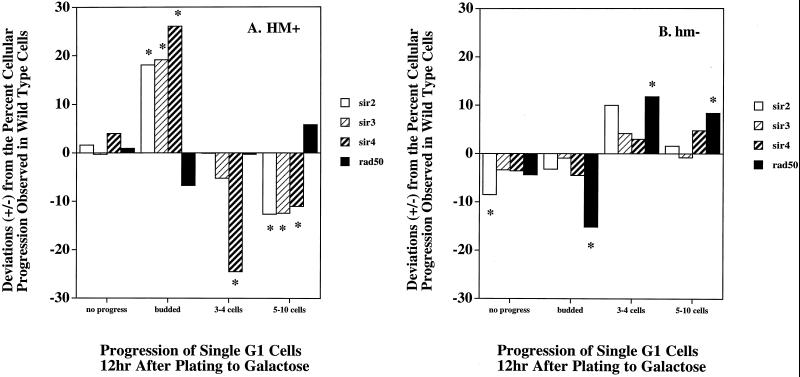FIG. 3.
Effects of a single persistent double-strand break within a dispensable YAC on cell cycle progression of single (G1) cells. Either the HO target sites in sir2Δ , sir3Δ , sir4Δ, and rad50Δ LS20-derived strains containing the u8 YAC were precisely deleted (HM+) (A) or HML and HMR were completely deleted (hm−) (B). The HM+ cells retained the a1/α2 mating type gene regulators and expressed an a1/α2 haploid (nonmating) phenotype in sir− strains. Cells were grown and washed as described in the legend to Fig. 1 and then spread onto SC-GAL plates using a multipin pronging device. For each mutant strain, two isolates were examined microscopically using a Singer MSM dissecting microscope and compared to the corresponding wild-type parental strain (8, 9). Individual cells (>400 for each bar in the graph) were examined immediately after being plated to the SC-GAL medium and 12 h later. At the time of plating, all isolates had similar distributions of cells: ∼50% were G1 (single cells), ∼25% were S (small budded), and ∼25% were G2 (large budded). Presented are the results for the cells that were in G1 (unbudded cells) (A and B) at the time of plating. G1 cells either remained as initially plated (no progress), progressed to the budded stage, progressed to the 3- to 4-cell stage, or formed microcolonies (5 to 10 cells). The mean percentage of cells for the wild-type parental strain was subtracted from the mean percentage obtained for each mutant strain in each category. Mutant strains that contained a higher percentage of cells in a given category had positive values, whereas mutant strains that had fewer cells in a given category had negative values. The deviations from the wild-type value (baseline = 0) for these mean percentages are indicated by bars. An ∗ over a bar indicates a deviation from the wild-type value that is significant (±1 standard deviation). Cells that were in G2 at the time of plating either remained as initially plated (budded), progressed to the 3- to 4-cell stage, or formed microcolonies (5 to 10 cells and >10 cells; data not shown). For the sir2Δ, sir3Δ, and sir4Δ cells able to form an a1/α2 haploid phenotype (HM+) (A), a persistent DSB in the u8 YAC leads to the accumulation of cells at G2 (i.e., as budded cells [22, 84]). No G2 delay was observed in sir2Δ, sir3Δ, and sir4Δ cells lacking the u8 YAC or those without the HML and HMR loci (hm−) (B). Similarly, sir2Δ, sir3Δ, and sir4Δ cells able to form an a1/α2 haploid phenotype that were in S or G2 (data not shown) at the time of plating, also accumulated at the subsequent G2 stage (i.e., as budded cells [22, 84]).

